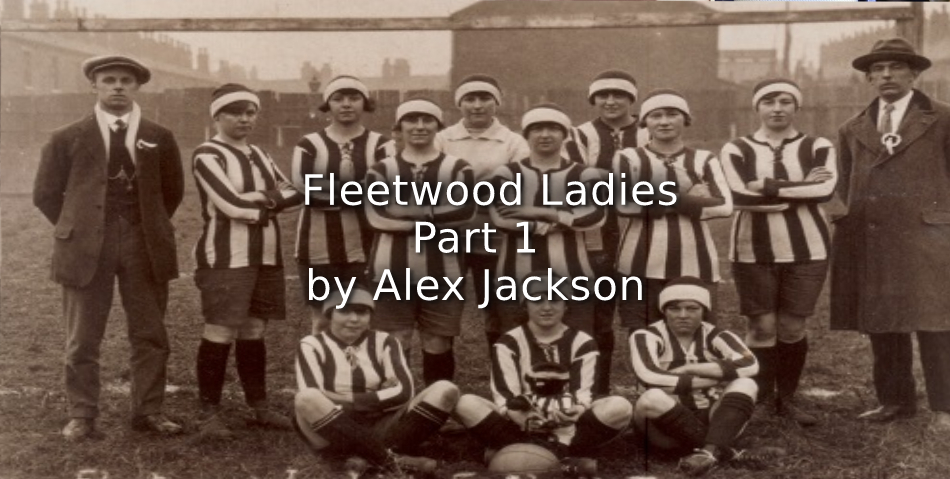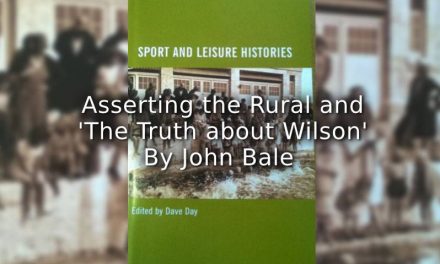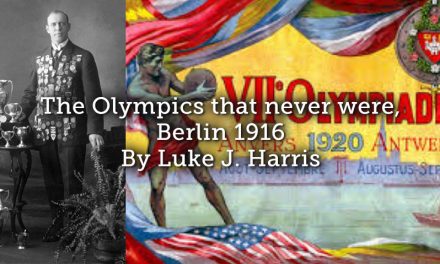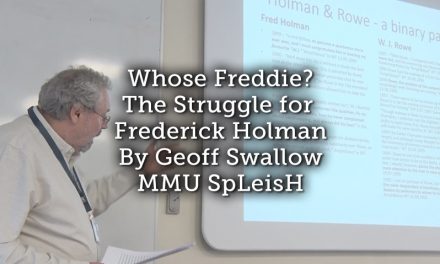On the 21 May 1921, fans crowded into the Oval stadium in Belfast. Normally they would come to see the men of Glentoran FC but on this occasion they came to see a women’s game, Belfast v Lancashire. Representing the red rose county were Fleetwood Ladies. They had played their first game only six months earlier. As they posed for special pre-match photographs, they might have been forgiven at marvelling at the level of interest they now attracted. On their arrival in Belfast, they had been treated as honoured guests, taken on special motor-tours and to the Hippodrome theatre. After the game they would be taken for dinner by local Unionist politicians. But seven months later the English FA declared, ‘the game of football is quite unsuitable for females and ought not to be encouraged.’ The FA banned its clubs from hosting women’s games and within a year Fleetwood Ladies seem to have disappeared.

Fleetwood Ladies, 1921
Courtesy of Patrick Brennan
As part of the National Football Museum’s 50:50 Strategy and our Lily Parr Project, funded by AIM Biffa Award History Makers, we have been exploring the stories of teams from this period. Starting with a single postcard in our collections, we have used digitised newspapers, census records and other documents to piece together a brief history of a team that enjoyed a short but fascinating life. Three articles will look at the team’s history, explore the social background of the players and officials, and analyse the media coverage they attracted. In 1921, this group of working-class women would play at least twenty-six games, attracting over 90,000 spectators and raising over £3,000 for charity. Many of these charities were connected to the legacy of the First World, a conflict that cost the lives of several of their loved ones.
Fleetwood
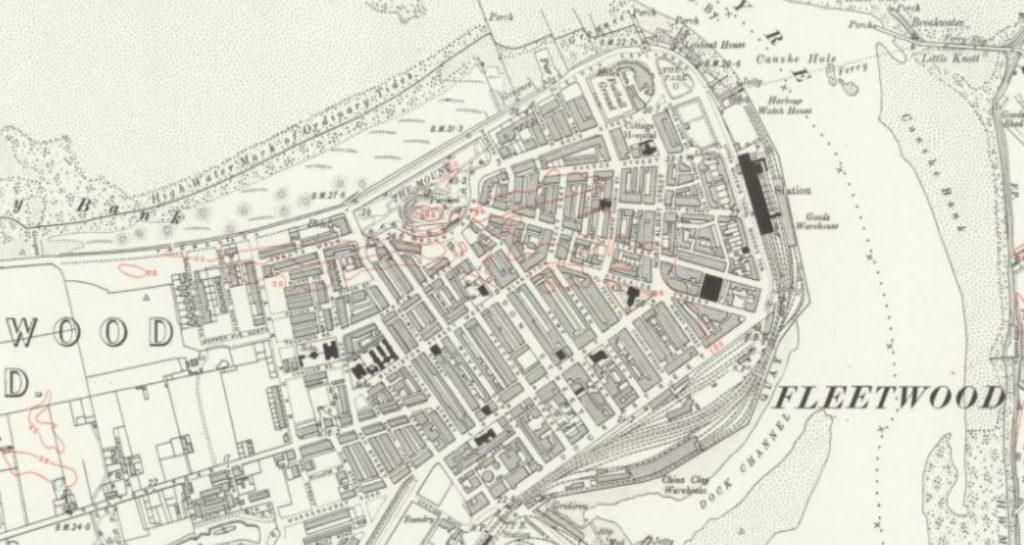
Ordnance Survey Map of Fleetwood, 1914. Note the distinctive spokes radiating from the Mount
Reproduced with the permission of the National Library of Scotland
To see the map in more detail see https://maps.nls.uk/view/101101214.
Fleetwood is a small town situated on the north-west of the Fylde Coast in Lancashire. Its layout is distinctive since much of it was designed as a model town in the 1840s. Originally it prospered as a transport hub. With no direct train route from London to Scotland, travellers sailed from Fleetwood by steamer up the west-coast. However, when a direct route was created the town’s fortunes faded. In the 1870s the focus turned to fishing, with new docks making it third largest fishing port in the country. By 1911 the population of the town was 15,875. Those interested in football could watch the newly formed Fleetwood FC play in the Lancashire Combination.[1]
There is no record in the Fleetwood Chronicle of women’s football being played in the town during the First World War. It is a reminder that while the war played an important part in popularising women’s football in many parts of the country, there were still many areas that remained untouched. There seems to have been a similar stimulus though, with the first recorded appearance of the team being in a charity match, a common starting point for many wartime teams.
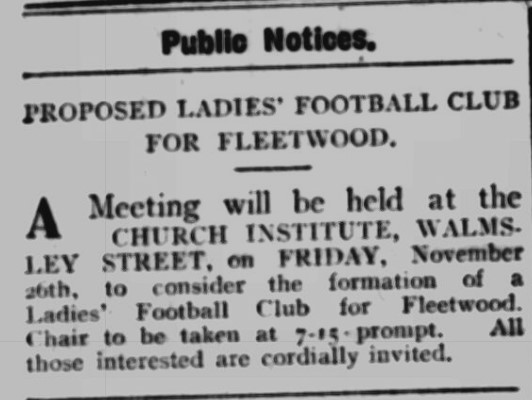
Fleetwood Chronicle, 19 November 1920
With thanks to the British Newspaper Archive
In November 1920, the Fleetwood Chronicle included a Public Notice, inviting anyone interested in forming a women’s team to attend a public meeting. There is no record of what was discussed or agreed but in December a game was scheduled. Fleetwood Ladies were to play ‘The Rest’ to raise funds for Fleetwood FC, who had just moved to a new ground, and the Discharged and Disabled Soldiers and Sailors Federation. Sadly, no match report seems to exist for this game. It seems that local patronage was called for. The Fleetwood Chronicle’s regular gossip column, entitled ‘What the light-keeper wants to know’, asked:
Who was the author of the facetious letter sent to a well-known resident who declined to have anything to do with the ladies’ football club?
Are the ladies going to be adept at humorous letter-writing as they are at football?[2]
Between December 1920 and December 1921, twenty-nine fixtures were played or advertised. Most recorded games took place between January and August, with an apparent tail-off before the FA ban of December 1921. Of these, they won 8, drew 5 and lost 13, scoring 45 goals and conceding 54.
Table 1.1: Games played or scheduled to be played by Fleetwood Ladies FC, 1920-1922.
| Date | Opposition | Location | Score | Crowd |
| 27.12.20 | The Rest | Queen’s Ground, Fleetwood | Unknown if held | Unknown if held |
| 29.12.20 | Horreckses, Crewdson’s Ladies (Preston) | Queen’s Ground, Fleetwood | 1-2 | 2,000 |
| 29.1.21 | Chorley Ladies | Westhoughton, Taylor Park ground, Bolton | 0-4 | 7 to 8,000 |
| 5.2.21 | Horreckses, Crewdson’s Ladies (Preston) | Skelmersdale | 2-5 | 4,500 |
| 19.2.21 | Chorley Ladies | Leigh | 1-2 | 4,000 |
| 9.3.21 | Horreckses & Crewdson’s Ladies (Preston) | Blackpool | 3-2 | Not given |
| 19.3.21 | Horreckses, Crewdson’s Ladies (Preston) | Haslingdon | 3-1 | 2,000 |
| 25.3.21 | Chorley Ladies | North Euston Ground, Fleetwood | 1-2 | A large gate |
| 29.3.21 | Lancaster Ladies | Lancaster | 1-1 | 5,000 |
| 1.4.21 | Chorley Ladies | North Euston Ground, Fleetwood | 2-1 | Unknown |
| 2.4.21 | Barrow | Kendal | 2-2 | 5,000 |
| 9.4.21 | Chorley Ladies | St. George’s Park, Chorley | 2-2 | 1,000 |
| 16.4.21 | Horreckses, Crewdson’s Ladies (Preston) | Ormskirk | 2-1 | 4,000 |
| 22.4.21 | Horreckses, Crewdson’s Ladies (Preston) | Pilling | 2-3 | 1,000 |
| 26.4.21 | Dick, Kerr Ladies FC | Spotland, Rochdale | 0-5 | 12,000 |
| 27.4.21 | North-East Coast Ladies | Ayresome Park, Middlesbrough | 2-6 | 10,000 |
| 30.4.21 | Chorley Ladies | Wigan | 2-0 | 2,000 |
| 7.5.21 | Lancaster Ladies | Darwin | 0-1 | 5,000 |
| 14.5.21 | Horreckses, Crewdson’s Ladies (Preston) | Queen’s Ground, Fleetwood | 4-0 | Rain spoiled what undoubtedly would have been a large “gate” |
| 21.5.21 | Ireland | The Oval, Belfast (Glentoran FC ground) | 1-1 | Estimated 20,000 – but potentially unreliable. |
| 28.5.21 | Lancaster Ladies | North Euston Ground, Fleetwood | 1-1 | Over 2,000 |
| 1.6.21 | Bolton Ladies | Turf Moor, Burnley | 0-1 | 1,500 to 4,000 |
| 4.6.21 | Ireland | Solitude, Belfast (Cliftonville FC ground) | 1-3 | Estimates of 17,000 and 4,000. Gate income suggests max of 3,860 paying |
| 23.8.21 | Dick, Kerr Ladies FC | Southport | 0-4 | 9,000 |
| 8.10.21 | Rochdale Ladies | Stalybridge | 5-1 | 3,000 |
| 26.12.21 | Dick, Kerr Ladies FC | Ashton Park, Preston | 1-3 | 3,000 |
| 27.12.21 | Lyons Strand House | Woolwich, London | 6-0 | 7,000 |
| 4 or 11.3.22 | Dick, Kerr Ladies FC | Rawtenstall | Unknown if held | Unknown if held |
| 1922 | Manchester United (EWFA Cup, 1st Round) | Queen’s Ground, Fleetwood | Unknown if held | Unknown if held |
Sources: Fleetwood Chronicle, Rochdale Times, Belfast Telegraph, Northern Whig, Sport (Dublin), Domouth Women’s Football Website. My thanks to Steve Bolton for his assistance with compiling this data.
Looking at this list, it is striking that most games were not played in Fleetwood. In fact, they only played six times in their hometown, split equally between the Queen’s Ground, built in 1920 as the new home of Fleetwood FC built, and Fleetwood FC’s original site at the North Euston Ground, behind the North Euston Hotel. They played in sixteen other location across Lancashire, once in Cumbria (Kendal), North-Yorkshire (Middlesbrough) and London (Woolwich) and twice in Belfast in Ireland. A key feature of team’s experiences would have been travel to and from games, not unlike that of Dick, Kerr Ladies.

The focus of Fleetwood Ladies playing activities – The North-West of England
Author created map of the team’s games
This frequent travel was a result of the team being asked to play for charitable causes. While we might imagine that charities were supported by teams drawn from the immediate town or area, in many cases games were held between two invited teams. Of the ten teams that Fleetwood played, their most regular opponents were Horreckses, Crewdson’s Ladies from Preston. They played them seven times in Fleetwood (twice), Skelmersdale, Blackpool, Haslingdon, Ormskirk and Pilling. They played Chorley Ladies six times, three times against Dick, Kerr Ladies and Lancaster, twice against Ireland and six other opponents once.

Fleetwood’s most common opponents. Horrockses, Creasdon’s Ladies from Preston
Horrockses, Creasdon’s Ltd was a major textile manufacturer which became part of the Amalgamated Cotton Mills Trust in 1920.
Source: National Football Museum

Their other principal opponents. Chorley Ladies FC
Source: National Football Museum
The only estimate for a crowd in Fleetwood was for 2,000. If accurate, this is an impressive figure, equating to 7.5% of the town’s population in 1911. It compares favourably to gates of 3,000 or so for some Fleetwood FC games, although 7,000 did attend the visit of Eccles in March 1921. Most crowd numbers seem to have been estimates, which pose challenges in interpretation. The crowd for the game at Burnley was given as 4,000 by the Fleetwood Chronicle but as 1,500 by the Lancashire Evening Post. Perhaps the most difficult to assess are the two games held in Belfast. Both were large, 20,000 and 17,000 according to the Fleetwood Chronicle. However, the recorded gate receipts for the latter game were £193. Admission had been advertised at 1s, 6d, or 1s, so at the cheapest price the maximum attendance could have only been 3,860. This fits with a figure of 4,000 fans provided by the Dublin newspaper Sport.[3] It is presumed that this is the total before any deductions for the government amusement tax. Given the discrepancy, it seems wise to treat both large estimates from the Fleetwood Chronicle with a degree of caution.
Perhaps the most interesting games, from the travelling perspective, are the two to Belfast in the summer of 1921. These took place during the Irish War of Independence. In the first half of 1921 over 1,000 people had been killed. In July, a ceasefire would be signed, marking the end of three years of hostilities between the British Government and Irish Republicans, although violence continued afterwards. A formal treaty would be signed in December 1921 and ratified in 1922, leading to the creation of the Irish Free State, forerunner to the Republic of Ireland.

Belfast News-Letter, 21 May 1921.
With thanks to the British Newspaper Archive and IPC Media
Both of Fleetwood’s games had connections to the wider political situation. The first was held at the home of Glentoran FC, situated in the heart of Protestant East Belfast. The game was kicked off by Captain Dixon, a prospective Unionist member for the Ulster Parliament. Created in 1921, the Ulster Parliament became the Northern Irish Parliament after the partition of the island of Ireland. After the game, the teams were entertained to tea by Captain Dixon and three other Unionist candidates for East Belfast at the Carlton Café.

Northern Whig, 2 June 1921
Fleetwood were a late replacement for a team from Scotland.
With thanks to the British Newspaper Archive
Fleetwood’s second visit was also connected to the wider Unionist and British cause. While the first game had been in aid of the Belfast Hospital for Women and Children, the second was part of a wider programme of events supporting Earl Haig’s Warrior fund for ex-servicemen. Events in support of the fund were held across the Island of Ireland, ranging from theatrical performances, band concerts, contributions from cinema takings, grand fetes, and flag days. Sporting events were also arranged including boxing exhibitions and football matches. Such events were strongly associated with the Unionist cause and the day before the Fleetwood game, a female student watching a charity cricket match in Dublin had been fatally wounded when shots were fired by members of the Irish Republican Army at the participating British army officers.[4]
Originally, the game had been scheduled between teams representing Ireland and Scotland and was advertised as such as late as the 2 June. However, it seems that the Scottish team must have been unable to attend since Fleetwood played instead. Both games were organised by Diana Scott, wife of the Glentoran FC secretary, Walter Scott. She was a prominent organiser of women’s games in Belfast between 1917 and 1922 and you can read more about her on Playing Pasts.
Following their second trip to Ireland, Fleetwood seem to have only played three more games before the FA announced its ban in December 1921. The Fleetwood Chronicle reported that:
The attempted ban of the Football Association on the female sex playing football has left the Fleetwood Ladies football team and their supporters cold. Truth to tell, they look with amused contempt upon the effort of the Association to stamp out ladies football, which they think is actuated by jealousy. They are not going to allow the Association edict to interfere with their recreation, and the local team will to be heard of, provided they can secure a ground on which to play, as it is quite obvious the Football Club may not be so far favourable to loaning the Queen’s Ground in view of the mandate issued by the supreme authority. The Fleetwood ladies have been the means of raising many thousands of pounds for charities…the sport-loving people of Fleetwood are strong supporters of the ladies side, and follow their career with more than ordinary interest.[5]
The ban did not lead to an instant end to the activities of the club and its officials. One response to the FA’s ban was the formation of the English Ladies Football Association (ELFA) and Fleetwood’s Secretary, James Henry Longworth, was appointed as one of five Vice-Presidents of the ELFA on the 17 December 1921.[6]
Another response was for teams to organise games to refute the allegation that that they were dangerous for women. One of these was between Fleetwood and the famous Dick, Kerr Ladies. The Preston team were prominent in voicing their opposition and arranged for local members of the medical profession to attend a match held on Boxing Day. Kicking off the game was Dr Mary Lowry and afterwards she gave her opinion that the game was no more taxing than a day’s hard washing.
“These girls,” she added, “come on the field perfectly trained, and in the game they get no more wrenches than they would in tennis. They are so trained as as to be able to stand any slight strains, and indeed, we should be poorly made individuals if we could not bear a few wrenches. An open-air life is better for girls than a heavy life indoors. I can’t see any harm in the game if it is played under any decent sort of supervision.”[7]
Since both sides received endorsements from female medical practitioners, it is worth asking what made Dr Mary Lowry sympathetic to women’s football? In 1914 she had been the Chair of the Suffrage Society in Preston, indicating her support for the advancement of women’s rights. Between 1917 and 1919 she was Preston’s Tuberculosis Officer, followed by a part-time post as Preston’s Maternity and Children’s Welfare Office. In 1920 Preston’s Medical Officer of Health died and Mary served as a temporary replacement until his successor was appointed. One local paper noted that, ‘Dr Mary Lowry was thus the first woman in England to hold the position of medical officer of health to a municipality.’[8] By the 1930s she was assisting her husband in post-mortem examinations. Mary took the lead in providing evidence in the Coroner’s Court, with her remarks so precise and full that further questions were generally unnecessary.[9] In her own field, she too was pushing against conventions.
After this game, Fleetwood played one more game against Lyon’s in London. Thereafter, we only have mentions of intended games. In March 1922 it was reported that they were looking to play their first game of the year against Dick, Kerr Ladies at Rawtenstall. However, no record of the game taking place has been found. The same applies to Fleetwood’s fixture in the inaugural ESFA Cup of 1922. They were one of twenty-three ESFA clubs who entered and were drawn at home to Manchester United in the 1st Round. The game had not been played when the 2nd Round was drawn, but it was Manchester United who were drawn to play Doncaster in the 3rd Round.[10]
The Fleetwood Chronicle is frustratingly quiet on what happened to the team. Searches have revealed just one final reference to the team. On one Sunday evening in October 1922, a group of young women scaled the walls of the Mount Grounds in Fleetwood. The paper recorded the incident in its ‘Query column’, asking who they were and whether ‘they are thinking of joining the Gymnasium or the Ladies Football Club?’ This brief item is the last reference to Fleetwood Ladies FC in the paper.

Fleetwood Chronicle, 6 October 1922
Thanks to the British Newspaper Archive
Article © of Alex Jackson
Part 2 – Fleetwood Ladies: Players and Officials can be read HERE
Acknowledgments
I would like to thank Steve Bolton and Professor Robert Hess for their help with these articles
References
[1] https://www.visitfleetwood.info/about/history/history-of-fleetwood/, accessed 10.12.2020.
[2] Fleetwood Chronicle, 31 December 1920.
[3] This describes the game as being between Ireland and Scotland. However, this was how the fixture was originally described and the score provided is the same as in the Fleetwood game. There are no other separate reports of Ireland playing Scotland.
[4] Northern Whig, 4 June 1921.
[5] Fleetwood Chronicle, 23 December 1921.
[6] http://donmouth.co.uk/womens_football/elfa.html, accessed 20.12.2020.
[7] Lancashire Evening Post, 27 December 1921.
[8] Lancashire Evening Post, 21 October 1925.
[9] Lancashire Evening Post, 10 January 1935.
[10] Ibid.

